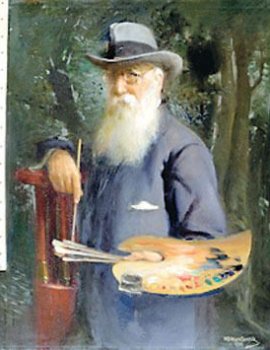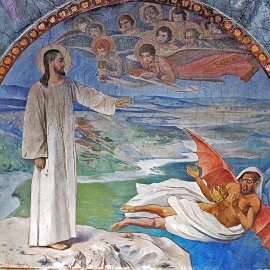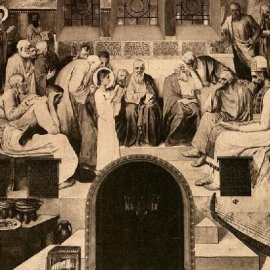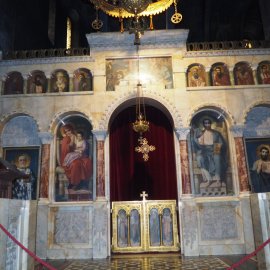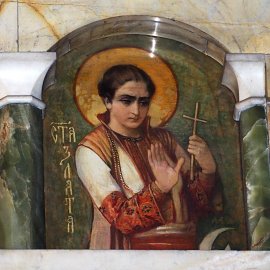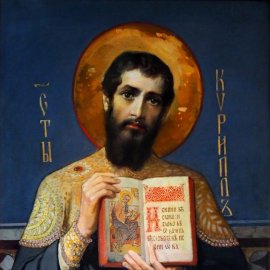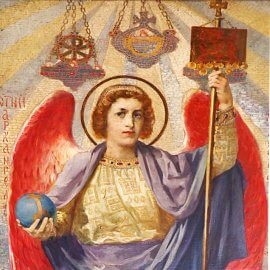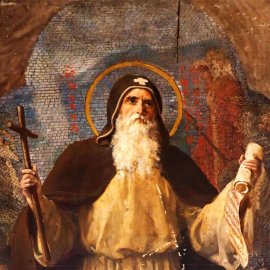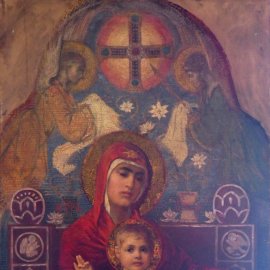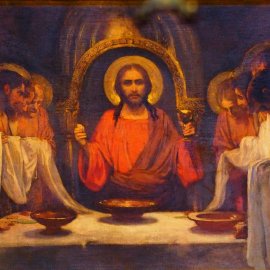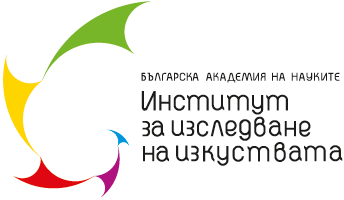Basic information
Born: 24 April 1856 (village of Vidim, Northern Czechia)
Died: 16 May 1938 (Prague, Czechoslovakia)
Art education
1873–1876 - Academy of Fine Arts, Prague (under Antonín Lhota);
1876–1877 - Academy of Fine Arts, Munich (under Otto Seitz);
Painting in the churches of Sofia
- 1903 – Church of St. John of Rila in the Theological Seminary – icons;
- about 1907 – Church of St. Nedelia (Kyriake) – an icon for the iconostasis;
- 1911–1912 – St. Alexander Nevsky Cathedral – icons and murals;
State of research
The work of Ivan Mrkvička has been examined in different aspects by a number of authors1Raynov 1928: 164-165; Protich 1933; Protich 1953: 36-46; Dinova 1956: 41-50; Bozhkov 1962; Avramov 1969: 22-34; Bozhkov 1978; Dinova-Ruseva 1976a: 44-72; Zhelyazkova 1995-1996: 16-23; Dinova-Ruseva 1996–1997: 261-265; Dinova-Ruseva 2009: 14-21; Asparuhova 2009; Asparuhova 2010: 31-35; Petkov, Fileva, Balcheva-Bozhkova 2016; Sokolova, Terzieva, Valchanova 2016.. Some researchers have commented his church works in particular in relation to the new plastic language that was established in the painting in the most representative churches after the Liberation2Vasiliev 1970; Dinova-Ruseva 1976: 135-153; Bozhkov 1989; Doncheva 1999: 77-82; Aleksandrova 2007: 126-131; Asparuhova 2010; Dinova-Ruseva 2014: 198-205. by lastingly replacing the Revival-era stylistics, or in the context of the history of the individual churches3Paskaleva 1986; Karavelov 1966; Radkova 1999; Prashkov 2005: 233-237; Asparuhova 2007: 7.. In the only monograph on the artist Mrkvička’s religious work was deliberately belittled and ignored. Andrey Protich merely noted the presence of his works at St. Alexander Nevsky Cathedral and his role in entrusting the icons for the newly built church at the Theological Seminary and the mosque-turned-church of the Sts. Heptarithmoi to painters and not to icon-painters4Protich 1955: 11, 12..
Biography
Jan Václav Mrkvička was born on 24 April 1856 in the village of Vidim near Duba in Northern Czech Republic6Dinova-Ruseva 2009: 21.. His professional interest in fine art came from Mrkvička’s grandfather’s brother who was a teacher in drawing and also from his uncle Josef who turned his young nephew to drawing and visiting art exhibitions7Dinova-Ruseva 2009: 15.. At 17 Mrkvička enrolled in the Academy of Fine Arts in Prague in the class of Antonín Lhota8Velikov 1995: 111.. On 25 October 1876, he enrolled in the Academy of Fine Arts in Munich where the young artist was admitted to the class of Otto Seitz in a studio for painting for advanced students9Dinova 1956: 41; Entsiklopediya 1987: 166, 167.. Because he lacked funds he remained in the course only for eight months and then returned to Prague. In the Czech capital he got into the milieu of the Bulgarian students and became one of the founders of Bulgarska Sedyanka Society10Mrkvička did not take the compulsory introductory Antique Class, i.e. painting of plaster casts of antique works. This course was taken by Nikolay Pavlovich in 1856-1857 and by Ivan Angelov in 1882- 1883. See Dinova-Ruseva 2009: 15.. Thanks to the connections he had built with the Bulgarians he was invited to teach in Plovdiv11Dinova 1956: 41; Zhelezarova 1995–1996: 19. . Mrkvička came to Bulgaria in 1882 when he was twenty-six years old12A colleague and classmate from the Lucas-Gymnasium who taught Chemistry and Physics at the highschool in Plovdiv proposed to him to take the position of an Art teacher. See Velikov 1995: 113.. He was appointed teacher at the high school of Plovdiv where he managed to pass a number of useful reforms. Aided by Petko Karavelov and Petko Slaveykov Mrkvička managed to have drawing become a mandatory subject not only in the senior classes at secondary schools but also in the elementary, handicraft and agricultural school13Protich 1955: 5.. Konstantin Velichkov and Mrkvička intended to open an art school in Plovdiv but their intentions were thwarted by the Unification of the Principality of Bulgaria and Eastern Rumelia in 188514Protich 1953: 38. . As a professor at the Art School he participated in a number of commissions: for a state examination at secondary schools, for purchasing paintings, for the organization of the historic house and home museums, for the copies of the frescoes at the Boyana Church, etc.15Protich 1955: 7. During his stay in Plovdiv the artist also realized his first art exhibitions16Pravcheva 1979: 245-246..
In 1889, Ivan Mrkvička was moved to a teaching position at Sofia Men’s Art High School. The next year he made his first one-man art exhibition in the capital city17През 1886 г. Мърквичка прави самостоятелна изложба в Пловдив. През 1887 г. съвместно с Антон Митов е реализирана втора изложба в салона на гимназията. Виж Динова-Русева 1991: 262..
Mrkvička’s role in the institutionalization of the artistic life in Sofia after the Liberation is undoubted. He was in the center of the Society for Support for the Art in Bulgaria established in Sofia in 1893 and became its first deputy chair18Protich 1955: 8.. The platform of the Association Society included the organization of collective exhibitions, the issuing of a magazine on fine art and the establishment of a state school of art. These tasks were accomplished one by one: the four collective exhibitions were held from 1894 to 1899, Art magazine was published from 1895 to 189919Protich 1953: 39. .
The greatest achievement of the Society for Support for the Art in Bulgaria in the formation the new structure of the artistic life in Bulgaria after the Liberation was the opening of the State Art School in 1896. In the Statement of the reasons under the Bill on the opening of the State Art School in Sofia20Rangelova 2012: 5-19. , prepared by the Society for Support for the Art in Bulgaria one of the reasons for opening of the school pointed out is the need of “artists, teachers for the elementary, secondary and handicraft schools, masters and directors for the artistic industry, icon-painters – in order to raise up the craft.” The Revival-era icon-painting was subject to sharp criticism21 For the entire text see Velichkov 1895: 23-26. The Bill on establishing a State Art School speaks of a new icon-painting that must be created on the basis of the academic principles22Velichkov 1895: 25, 26. This critical attitude towards icon painting during the Revival was promoted by the closest associate of Mrkvička, Anton Mitov (on behalf of the Italian Tonino) also in his “Letters on Bulgaria” filled with sharp criticism of the low level of icon painting in the country. See Tonino 1895: 7-10.. At this point it should be noted that after the school opened Ivan Mrkvička was the first academically trained teacher in icon painting in Bulgaria23Ivanova-Tsotsova 1990: 24..
Out of the initial team of teachers numbering nine persons in 1900, church commissions were taken up only by Mrkvička and Mitov24Bozhkov1962: 5. The initial academic staff included Ivan Mrkvička (Director and Head of the Painting Atelier), Anton Mitov (Painting and Art History), Boris Schatz (Modelling) and Dr. Sarafov (Anatomy). In 1898 they were joined by five more teachers: Jaroslav Věšín (Painting and Life Drawing Evening ), Antonín Šourek (Constructive Perspective), Zheko Spiridonov (Modelling and Sculpture), Raymond Ulrich (Paining and Decorative Art) and Arch. Yordan Milanov (Architecture).. In 1903, Ivan Mrkvička was the driver that managed to secure icons to be painted for the Church of Sts. Heptarithmoi, for the Church of St. John of Rila at the Theological Seminary and for the mausoleum in Pleven. He managed to have his way with the Holy Synod by convincing them that the churches must have iconostases with icons painted by artists and not by icon-painters25Protich 1953: 43..
Mrkvička did religious paintings for the Church of the Theological Seminary, for the mausoleum of Evlogi Georgiev and Hristo Georgive in the Bellu Cemetery in Bucharest (1906)26Мърквичка създава декоративномонументални живописни пана: Богородица Оранта сред ангели, Христос, Св. Евлоги, 12-те апостоли, Християнско милосърдие и Херувими. Тези живописни творби се родеят по стил със стенописите на Иван Мърквичка в храм-паметник „Св. Александър Невски“. Виж Динова-Русева 1976: 149-153., for the chapel mausoleum in Pleven (1907)27Иван Мърквичка рисува десет икони – две царски: Св. Георги Победоносец и Богородица с Младенеца, както и иконите от апостолския ред с изображенията на апостолите Яков, Тома, Симон, Йоан, Лука, Петър, Павел и Матей. Виж Аспарухова 2007: 101-113., for St. Alexander Nevsky Cathedral.
Painting in the churches of Sofia
For the Church of St. John of Rila in the Theological Seminary Mrkvička painted three majesty icons28The size of these icons is 14,5/ 62 cm : St. Archangel Michael29The icon is signed in the lower left corner by Ivan Mrkvička, dated 1903., St. John of 30The icon is not signed but its style suggests that it was painted by Ivan Mrkvička. and the Holy Mother of God with the infant Jesus31Signed in the lower left corner by Ivan Mrkvička, dated 1903.. They were painted with oils on factory-made primed canvass stretched on a V-shaped sub-frame32Prashkov 2005: 233. They are currently kept at the library of the Seminary. In one archival photography one can see their arrangement on the iconostasis33Photograph: http: //stara-sofia.com/seminaria.html (last visited on 05 January 2020). The icons painted by Mrkvička are in the northern part of the iconostasis.
An icon from the iconostasis of the Church of St. Nedelia (Kyriake) was also authored by Ivan Mrkvička. It is an icon of the Last Supper situated in the middle of the Apostles tier, above the royal doors. It is singed in the bottom right-hand corner and is not dated. The composition of the scene is interesting since it is built in depth. In the center, as tradition has it, is depicted Christ holding the gifts of the Eucharist – a chalice of wine in one hand and a bread in the other. The apostles to his left and right sides are perceptively depicted in depth holding a white cloth. An archival photography of the iconostasis of the church of 191934Photograph: http: //stara-sofia.blogspot.com/2012/04/blog-post_16.html (last visited on 05.01.2020) shows that the icon of the Last Supper was already present on the iconostasis. Most likely it was painted about 1907 when, in September, the church’s board of trustees held a competition for a new iconostasis to be made, which was installed in March 1915. This iconostasis, with some repairs made after the 1925 assault, is preserved to date35Temelski 2010: 17..
For St. Alexander Nevsky Cathedral Mrkvička made all icons from the northern iconostasis in the period 1911–191236Radkova 1999: 73.. The icons from the Sovereign tier are: St. Methodius, the Holy Mother of God with the infant Jesus, Christ on a throne, St. Cyril. The second register of the iconostasis consists of eight small icons: of St. Paraskeva, St. Sava, St. Gorazd, St. Naum of Ohrid, St. Clement of Ohrid, St. Angelar, St. Euthymius of Tarnovo, St. Zlata of Maglen. In the center underneath the crucifix is the icon of the Descent from the Cross. On the royal doors are depicted some Old Testament prophets: Moses, Aaron, Jeremiah and Elias, painted with oils on metal. In 1912, Mrkvička painted the scene of Jesus among the scribes in the church on the northern wall and two scenes in the southern gallery: Beheading of St. John the Baptist and the Temptation of Christ37Pravcheva 1979: 245..
Vesselina Yontcheva

